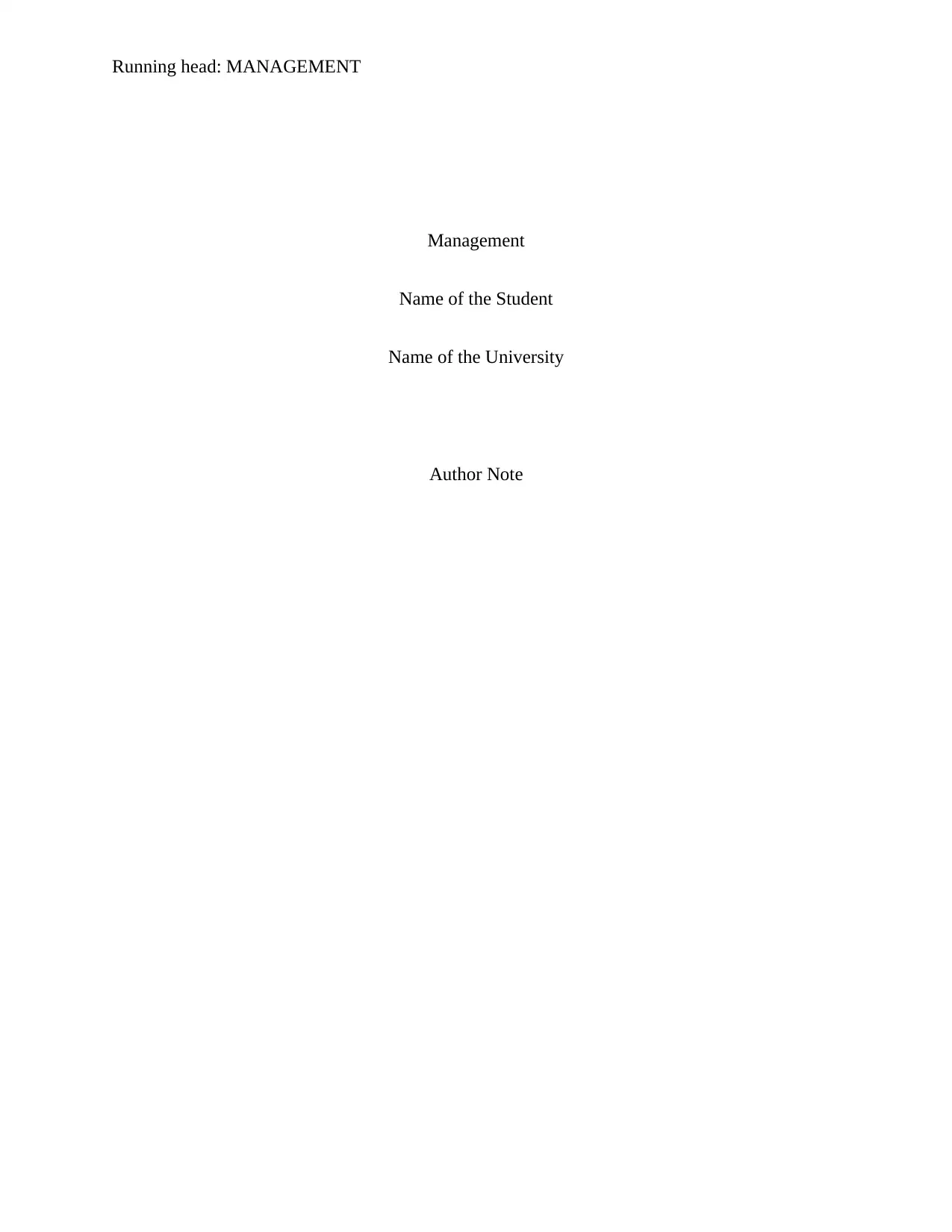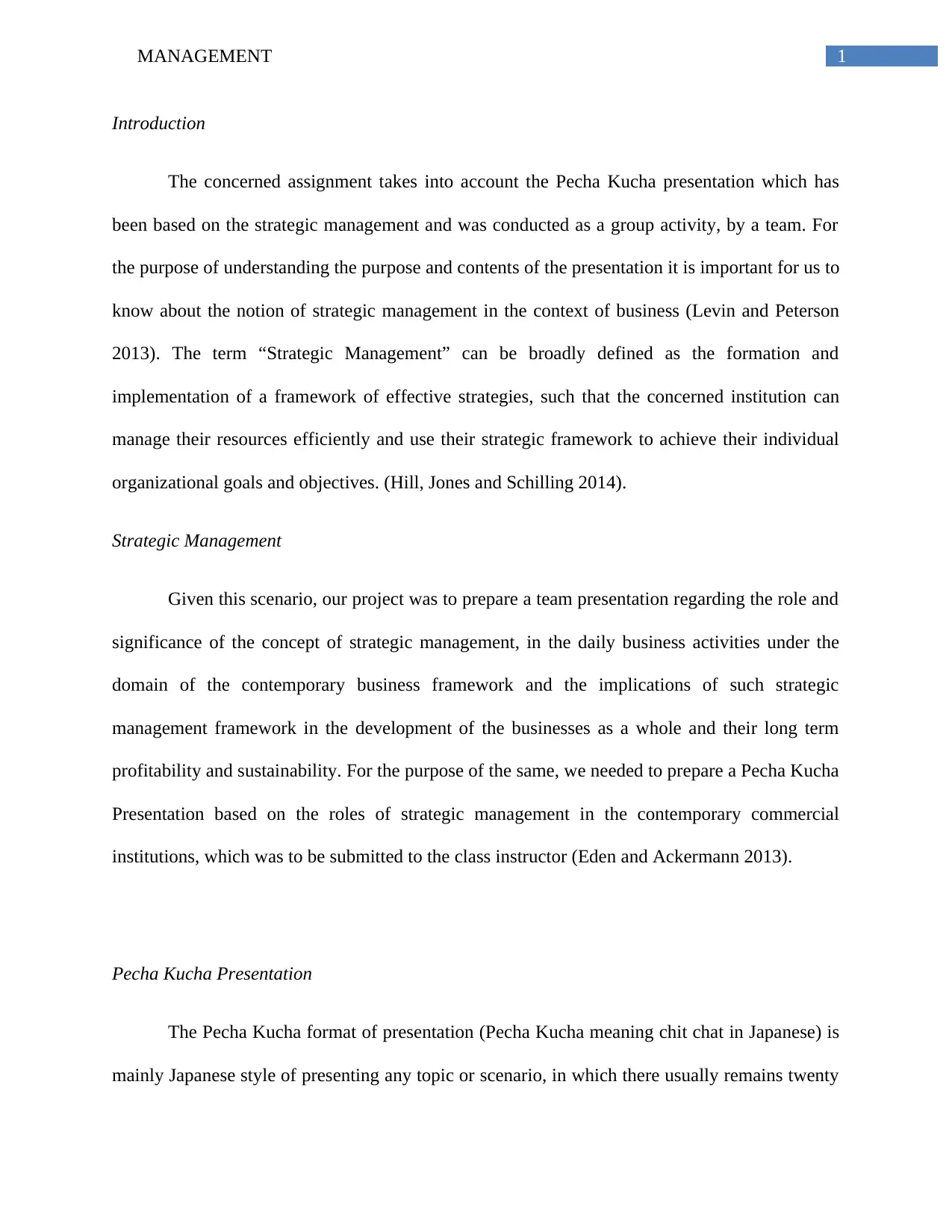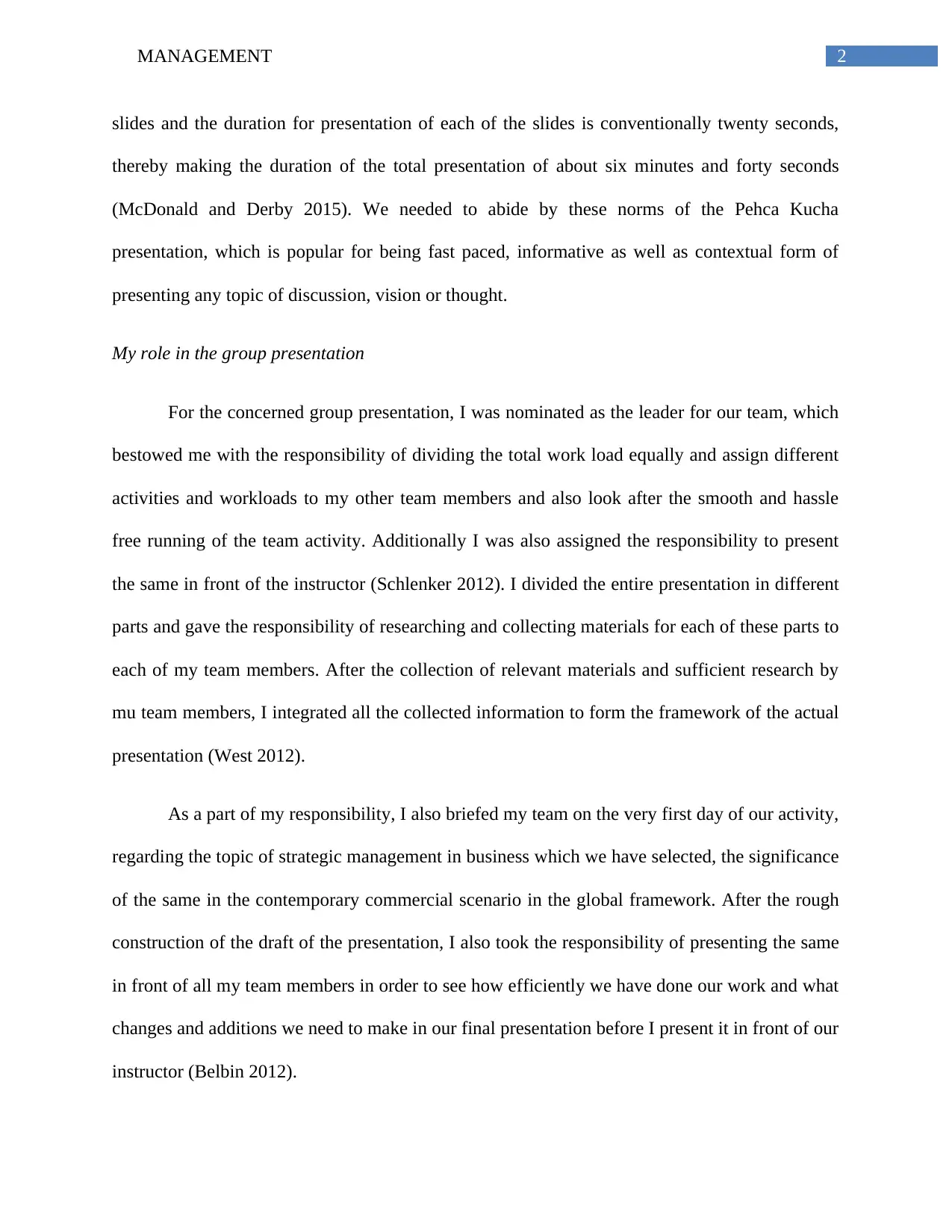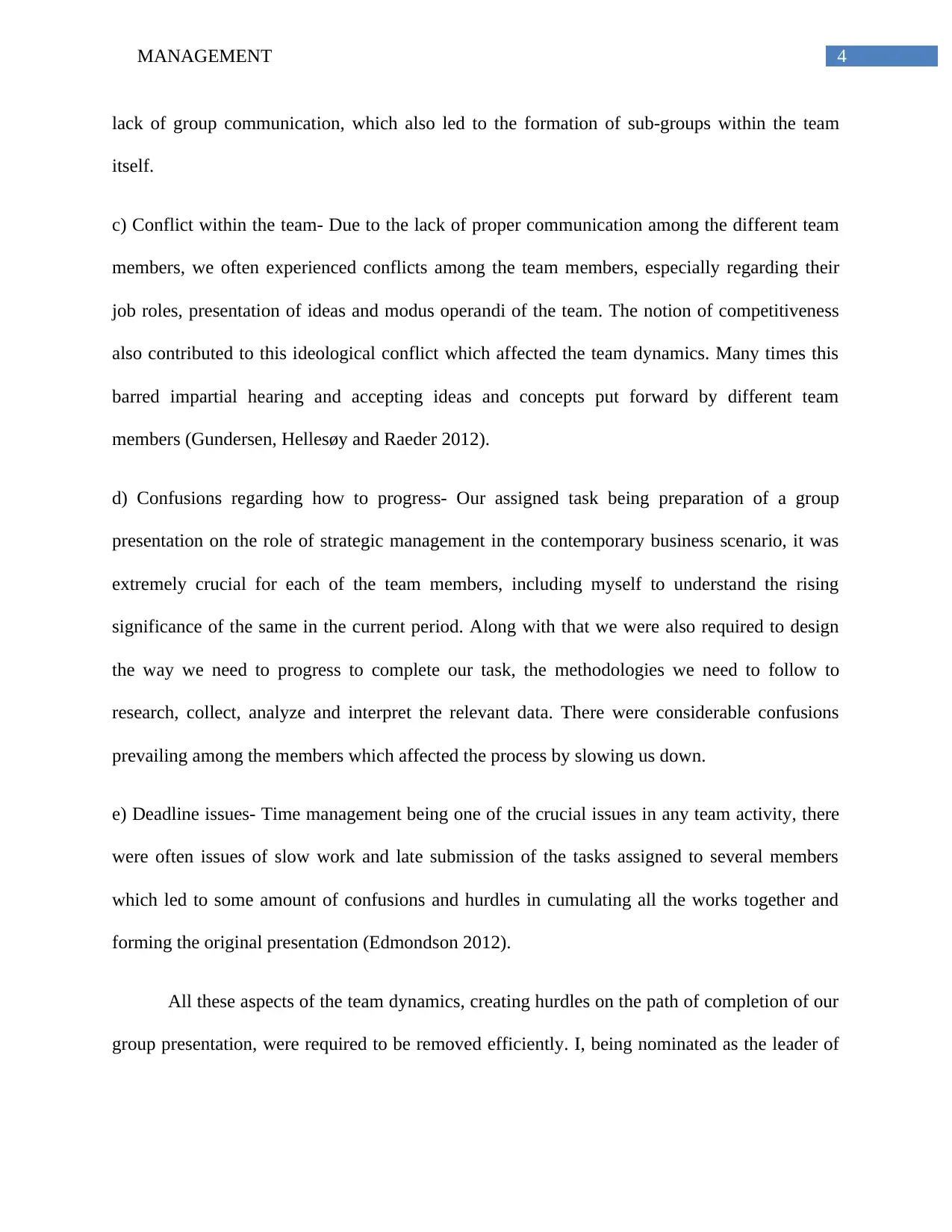Effective Leadership in Overcoming Teamwork Challenges
VerifiedAdded on 2020/05/28
|9
|1951
|106
AI Summary
The reflective essay details the experience of leading a group tasked with delivering a Pecha Kucha presentation. The writer describes initial challenges such as lack of communication, conflict among members, and poor time management. As the leader, they implemented strategies to foster better interaction through informal discussions and team meetings, established deadlines for task completion, and encouraged open idea exchange. These efforts improved the team's dynamics, leading to a more harmonious and productive working environment. The essay concludes by highlighting key lessons learned about effective leadership, particularly in the areas of time management, communication, and prioritizing group objectives over individual ones.

Running head: MANAGEMENT
Management
Name of the Student
Name of the University
Author Note
Management
Name of the Student
Name of the University
Author Note
Paraphrase This Document
Need a fresh take? Get an instant paraphrase of this document with our AI Paraphraser

1MANAGEMENT
Introduction
The concerned assignment takes into account the Pecha Kucha presentation which has
been based on the strategic management and was conducted as a group activity, by a team. For
the purpose of understanding the purpose and contents of the presentation it is important for us to
know about the notion of strategic management in the context of business (Levin and Peterson
2013). The term “Strategic Management” can be broadly defined as the formation and
implementation of a framework of effective strategies, such that the concerned institution can
manage their resources efficiently and use their strategic framework to achieve their individual
organizational goals and objectives. (Hill, Jones and Schilling 2014).
Strategic Management
Given this scenario, our project was to prepare a team presentation regarding the role and
significance of the concept of strategic management, in the daily business activities under the
domain of the contemporary business framework and the implications of such strategic
management framework in the development of the businesses as a whole and their long term
profitability and sustainability. For the purpose of the same, we needed to prepare a Pecha Kucha
Presentation based on the roles of strategic management in the contemporary commercial
institutions, which was to be submitted to the class instructor (Eden and Ackermann 2013).
Pecha Kucha Presentation
The Pecha Kucha format of presentation (Pecha Kucha meaning chit chat in Japanese) is
mainly Japanese style of presenting any topic or scenario, in which there usually remains twenty
Introduction
The concerned assignment takes into account the Pecha Kucha presentation which has
been based on the strategic management and was conducted as a group activity, by a team. For
the purpose of understanding the purpose and contents of the presentation it is important for us to
know about the notion of strategic management in the context of business (Levin and Peterson
2013). The term “Strategic Management” can be broadly defined as the formation and
implementation of a framework of effective strategies, such that the concerned institution can
manage their resources efficiently and use their strategic framework to achieve their individual
organizational goals and objectives. (Hill, Jones and Schilling 2014).
Strategic Management
Given this scenario, our project was to prepare a team presentation regarding the role and
significance of the concept of strategic management, in the daily business activities under the
domain of the contemporary business framework and the implications of such strategic
management framework in the development of the businesses as a whole and their long term
profitability and sustainability. For the purpose of the same, we needed to prepare a Pecha Kucha
Presentation based on the roles of strategic management in the contemporary commercial
institutions, which was to be submitted to the class instructor (Eden and Ackermann 2013).
Pecha Kucha Presentation
The Pecha Kucha format of presentation (Pecha Kucha meaning chit chat in Japanese) is
mainly Japanese style of presenting any topic or scenario, in which there usually remains twenty

2MANAGEMENT
slides and the duration for presentation of each of the slides is conventionally twenty seconds,
thereby making the duration of the total presentation of about six minutes and forty seconds
(McDonald and Derby 2015). We needed to abide by these norms of the Pehca Kucha
presentation, which is popular for being fast paced, informative as well as contextual form of
presenting any topic of discussion, vision or thought.
My role in the group presentation
For the concerned group presentation, I was nominated as the leader for our team, which
bestowed me with the responsibility of dividing the total work load equally and assign different
activities and workloads to my other team members and also look after the smooth and hassle
free running of the team activity. Additionally I was also assigned the responsibility to present
the same in front of the instructor (Schlenker 2012). I divided the entire presentation in different
parts and gave the responsibility of researching and collecting materials for each of these parts to
each of my team members. After the collection of relevant materials and sufficient research by
mu team members, I integrated all the collected information to form the framework of the actual
presentation (West 2012).
As a part of my responsibility, I also briefed my team on the very first day of our activity,
regarding the topic of strategic management in business which we have selected, the significance
of the same in the contemporary commercial scenario in the global framework. After the rough
construction of the draft of the presentation, I also took the responsibility of presenting the same
in front of all my team members in order to see how efficiently we have done our work and what
changes and additions we need to make in our final presentation before I present it in front of our
instructor (Belbin 2012).
slides and the duration for presentation of each of the slides is conventionally twenty seconds,
thereby making the duration of the total presentation of about six minutes and forty seconds
(McDonald and Derby 2015). We needed to abide by these norms of the Pehca Kucha
presentation, which is popular for being fast paced, informative as well as contextual form of
presenting any topic of discussion, vision or thought.
My role in the group presentation
For the concerned group presentation, I was nominated as the leader for our team, which
bestowed me with the responsibility of dividing the total work load equally and assign different
activities and workloads to my other team members and also look after the smooth and hassle
free running of the team activity. Additionally I was also assigned the responsibility to present
the same in front of the instructor (Schlenker 2012). I divided the entire presentation in different
parts and gave the responsibility of researching and collecting materials for each of these parts to
each of my team members. After the collection of relevant materials and sufficient research by
mu team members, I integrated all the collected information to form the framework of the actual
presentation (West 2012).
As a part of my responsibility, I also briefed my team on the very first day of our activity,
regarding the topic of strategic management in business which we have selected, the significance
of the same in the contemporary commercial scenario in the global framework. After the rough
construction of the draft of the presentation, I also took the responsibility of presenting the same
in front of all my team members in order to see how efficiently we have done our work and what
changes and additions we need to make in our final presentation before I present it in front of our
instructor (Belbin 2012).
⊘ This is a preview!⊘
Do you want full access?
Subscribe today to unlock all pages.

Trusted by 1+ million students worldwide

3MANAGEMENT
This rehearsal in front of my team was necessary, as this also facilitated discussions and
integration of the concepts and ideas of different team members regarding different aspects of the
presentation. This integration was immensely crucial as it helped us in overcoming the flaws and
hurdles which were faced by the team members individually, in their own assigned job roles and
research and this made our presentation robust and informative in an overall basis. However,
during the entire time span of the team activity, there were several challenges and problems
faced among the team members which affected the team dynamics significantly, thereby giving
me the scope of utilizing my leadership skills in an efficient manner (Nancarrow et al. 2013).
Team Dynamics: Challenges faced in our team activity
While carrying out the group activity which was assigned to us, I noticed several issues
and challenges cropping up and considerable dynamics in our team, which affected our
productivity both individually as well as cumulatively:
a) Difficulty in getting started- The first and foremost hurdle which our team and I, as a leader,
faced while starting our activity was the problem of culminating the vision and objective of our
team activity and the purpose of the same among all the team members. The team members were
not highly communicative in the preliminary period, which made it a problem for me to
understand their strengths and what roles I can assign to them to make the best use of their skills
and abilities.
b) Ineffective communication- Another problem, hampering the team dynamics was the lack of
communication among the team members, especially during the initial starting time of our group
activity. There existed substantial misunderstandings among the different team members due to
This rehearsal in front of my team was necessary, as this also facilitated discussions and
integration of the concepts and ideas of different team members regarding different aspects of the
presentation. This integration was immensely crucial as it helped us in overcoming the flaws and
hurdles which were faced by the team members individually, in their own assigned job roles and
research and this made our presentation robust and informative in an overall basis. However,
during the entire time span of the team activity, there were several challenges and problems
faced among the team members which affected the team dynamics significantly, thereby giving
me the scope of utilizing my leadership skills in an efficient manner (Nancarrow et al. 2013).
Team Dynamics: Challenges faced in our team activity
While carrying out the group activity which was assigned to us, I noticed several issues
and challenges cropping up and considerable dynamics in our team, which affected our
productivity both individually as well as cumulatively:
a) Difficulty in getting started- The first and foremost hurdle which our team and I, as a leader,
faced while starting our activity was the problem of culminating the vision and objective of our
team activity and the purpose of the same among all the team members. The team members were
not highly communicative in the preliminary period, which made it a problem for me to
understand their strengths and what roles I can assign to them to make the best use of their skills
and abilities.
b) Ineffective communication- Another problem, hampering the team dynamics was the lack of
communication among the team members, especially during the initial starting time of our group
activity. There existed substantial misunderstandings among the different team members due to
Paraphrase This Document
Need a fresh take? Get an instant paraphrase of this document with our AI Paraphraser

4MANAGEMENT
lack of group communication, which also led to the formation of sub-groups within the team
itself.
c) Conflict within the team- Due to the lack of proper communication among the different team
members, we often experienced conflicts among the team members, especially regarding their
job roles, presentation of ideas and modus operandi of the team. The notion of competitiveness
also contributed to this ideological conflict which affected the team dynamics. Many times this
barred impartial hearing and accepting ideas and concepts put forward by different team
members (Gundersen, Hellesøy and Raeder 2012).
d) Confusions regarding how to progress- Our assigned task being preparation of a group
presentation on the role of strategic management in the contemporary business scenario, it was
extremely crucial for each of the team members, including myself to understand the rising
significance of the same in the current period. Along with that we were also required to design
the way we need to progress to complete our task, the methodologies we need to follow to
research, collect, analyze and interpret the relevant data. There were considerable confusions
prevailing among the members which affected the process by slowing us down.
e) Deadline issues- Time management being one of the crucial issues in any team activity, there
were often issues of slow work and late submission of the tasks assigned to several members
which led to some amount of confusions and hurdles in cumulating all the works together and
forming the original presentation (Edmondson 2012).
All these aspects of the team dynamics, creating hurdles on the path of completion of our
group presentation, were required to be removed efficiently. I, being nominated as the leader of
lack of group communication, which also led to the formation of sub-groups within the team
itself.
c) Conflict within the team- Due to the lack of proper communication among the different team
members, we often experienced conflicts among the team members, especially regarding their
job roles, presentation of ideas and modus operandi of the team. The notion of competitiveness
also contributed to this ideological conflict which affected the team dynamics. Many times this
barred impartial hearing and accepting ideas and concepts put forward by different team
members (Gundersen, Hellesøy and Raeder 2012).
d) Confusions regarding how to progress- Our assigned task being preparation of a group
presentation on the role of strategic management in the contemporary business scenario, it was
extremely crucial for each of the team members, including myself to understand the rising
significance of the same in the current period. Along with that we were also required to design
the way we need to progress to complete our task, the methodologies we need to follow to
research, collect, analyze and interpret the relevant data. There were considerable confusions
prevailing among the members which affected the process by slowing us down.
e) Deadline issues- Time management being one of the crucial issues in any team activity, there
were often issues of slow work and late submission of the tasks assigned to several members
which led to some amount of confusions and hurdles in cumulating all the works together and
forming the original presentation (Edmondson 2012).
All these aspects of the team dynamics, creating hurdles on the path of completion of our
group presentation, were required to be removed efficiently. I, being nominated as the leader of

5MANAGEMENT
the group had to take up this responsibility, which I did in the manner which is discussed in the
following section.
My role as a leader in ruling out the problems
As the leader of the team, I took the following steps to ensure that the team activity is
done efficiently with the consent of all the members and each member contributed efficiently and
not forcibly but happily:
a) Ensuring communication among the members- To rule out the problem of lack of
understanding among the team members, which I felt was extremely crucial to get the job done
smoothly, I arranged for frequent discussion sessions, often casual and over coffee, such that the
members mix with each other at a casual and informal level. This helped us to create a mutual
understanding among the team members and helped considerably in ruling out the intra-team
conflict (Edmondson 2012).
b) Setting up deadlines- I, after team discussion and consent from all the members, set up
deadlines for each task and encouraged the members to stick to the deadline and provide their
progress reports to the team, thereby creating an avenue to arrange for the succeeding tasks.
c) Free flow of ideas- To make the activity more interesting and to encourage each member, I
encouraged each of them to brainstorm and come up with their ideas freely and without any
inhibition in front of team discussions, which were frequently arranged. Each of the members
was made to feel equally important by giving them equal opportunities to speak, discuss,
critically evaluate others’ point of views and chances to come up with rectifications and
suggestions (Northouse 2015).
the group had to take up this responsibility, which I did in the manner which is discussed in the
following section.
My role as a leader in ruling out the problems
As the leader of the team, I took the following steps to ensure that the team activity is
done efficiently with the consent of all the members and each member contributed efficiently and
not forcibly but happily:
a) Ensuring communication among the members- To rule out the problem of lack of
understanding among the team members, which I felt was extremely crucial to get the job done
smoothly, I arranged for frequent discussion sessions, often casual and over coffee, such that the
members mix with each other at a casual and informal level. This helped us to create a mutual
understanding among the team members and helped considerably in ruling out the intra-team
conflict (Edmondson 2012).
b) Setting up deadlines- I, after team discussion and consent from all the members, set up
deadlines for each task and encouraged the members to stick to the deadline and provide their
progress reports to the team, thereby creating an avenue to arrange for the succeeding tasks.
c) Free flow of ideas- To make the activity more interesting and to encourage each member, I
encouraged each of them to brainstorm and come up with their ideas freely and without any
inhibition in front of team discussions, which were frequently arranged. Each of the members
was made to feel equally important by giving them equal opportunities to speak, discuss,
critically evaluate others’ point of views and chances to come up with rectifications and
suggestions (Northouse 2015).
⊘ This is a preview!⊘
Do you want full access?
Subscribe today to unlock all pages.

Trusted by 1+ million students worldwide

6MANAGEMENT
Lessons learnt: Scope of improvement
From our group work and from my responsibility as a team leader, the primary lesson
which I learnt and which will help me in my future team endeavor is the aspect of time
management. Me and the team as a whole also learnt the need to communicate efficiently and
come up with ideas without any inhibition. We also learnt that it is immensely important for each
member to keep the goals of the team above any other individual priorities. All these lessons
together are expected to improve our future abilities to work together in any project as a team.
Lessons learnt: Scope of improvement
From our group work and from my responsibility as a team leader, the primary lesson
which I learnt and which will help me in my future team endeavor is the aspect of time
management. Me and the team as a whole also learnt the need to communicate efficiently and
come up with ideas without any inhibition. We also learnt that it is immensely important for each
member to keep the goals of the team above any other individual priorities. All these lessons
together are expected to improve our future abilities to work together in any project as a team.
Paraphrase This Document
Need a fresh take? Get an instant paraphrase of this document with our AI Paraphraser

7MANAGEMENT
References
Belbin, R.M., 2012. Team roles at work. Routledge.
Eden, C. and Ackermann, F., 2013. Making strategy: The journey of strategic management.
Sage.
Edmondson, A.C., 2012. Teamwork on the fly. Harvard Business Review, 90(4), pp.72-80..
Teamwork on the fly. Harvard Business Review, 90(4), pp.72-80.
Gundersen, G., Hellesøy, B.T. and Raeder, S., 2012. Leading international project teams: The
effectiveness of transformational leadership in dynamic work environments. Journal of
Leadership & Organizational Studies, 19(1), pp.46-57.
Hill, C.W., Jones, G.R. and Schilling, M.A., 2014. Strategic management: theory: an integrated
approach. Cengage Learning.
Levin, M.A. and Peterson, L.T., 2013. Use of Pecha Kucha in Marketing Students'
Presentations. Marketing Education Review, 23(1), pp.59-64.
McDonald, R.E. and Derby, J.M., 2015. Active learning to improve presentation skills: The use
of pecha kucha in undergraduate sales management classes. Marketing Education Review, 25(1),
pp.21-25.
Nancarrow, S.A., Booth, A., Ariss, S., Smith, T., Enderby, P. and Roots, A., 2013. Ten principles
of good interdisciplinary team work. Human resources for Health, 11(1), p.19.
Northouse, P.G., 2015. Leadership: Theory and practice. Sage publications.
Schlenker, B.R., 2012. Self-presentation.
References
Belbin, R.M., 2012. Team roles at work. Routledge.
Eden, C. and Ackermann, F., 2013. Making strategy: The journey of strategic management.
Sage.
Edmondson, A.C., 2012. Teamwork on the fly. Harvard Business Review, 90(4), pp.72-80..
Teamwork on the fly. Harvard Business Review, 90(4), pp.72-80.
Gundersen, G., Hellesøy, B.T. and Raeder, S., 2012. Leading international project teams: The
effectiveness of transformational leadership in dynamic work environments. Journal of
Leadership & Organizational Studies, 19(1), pp.46-57.
Hill, C.W., Jones, G.R. and Schilling, M.A., 2014. Strategic management: theory: an integrated
approach. Cengage Learning.
Levin, M.A. and Peterson, L.T., 2013. Use of Pecha Kucha in Marketing Students'
Presentations. Marketing Education Review, 23(1), pp.59-64.
McDonald, R.E. and Derby, J.M., 2015. Active learning to improve presentation skills: The use
of pecha kucha in undergraduate sales management classes. Marketing Education Review, 25(1),
pp.21-25.
Nancarrow, S.A., Booth, A., Ariss, S., Smith, T., Enderby, P. and Roots, A., 2013. Ten principles
of good interdisciplinary team work. Human resources for Health, 11(1), p.19.
Northouse, P.G., 2015. Leadership: Theory and practice. Sage publications.
Schlenker, B.R., 2012. Self-presentation.

8MANAGEMENT
West, M.A., 2012. Effective teamwork: Practical lessons from organizational research. John
Wiley & Sons.
West, M.A., 2012. Effective teamwork: Practical lessons from organizational research. John
Wiley & Sons.
⊘ This is a preview!⊘
Do you want full access?
Subscribe today to unlock all pages.

Trusted by 1+ million students worldwide
1 out of 9
Related Documents
Your All-in-One AI-Powered Toolkit for Academic Success.
+13062052269
info@desklib.com
Available 24*7 on WhatsApp / Email
![[object Object]](/_next/static/media/star-bottom.7253800d.svg)
Unlock your academic potential
Copyright © 2020–2026 A2Z Services. All Rights Reserved. Developed and managed by ZUCOL.





